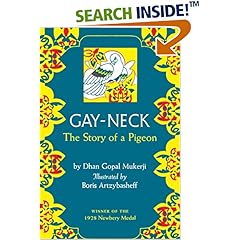
Dhan Gopal Mukerji was born near Calcutta in 1890 and came to the United States at the age of nineteen. So, I'm fairly sure he gets the atmosphere of life for a boy in early twentieth century India. Mukerji wrote other nature stories, including Kari the Elephant and Hari the Jungle Lad. In Gay-Neck, Mukerji gives a lot of information about pigeons and about training pigeons, and he imparts that information by means of a fascinating story of the adventures of one particular pigeon, Gay-Neck or Chitra-griva.
The descriptions of the pigeons' defense against their enemies, eagles and hawks, and of their capacity to deliver messages even in the midst of battle are detailed enough to make the reader feel as if he could go out, purchase a pigeon, and begin training tomorrow. And it sounds like fun. As an adult and a non-animal lover, I'm sure it's not that simple, but don't be surprised if a child, after reading this book, wants his own bird to train and watch and admire.
Gay-neck is admirable. Even when he gives in to fear after a deadly encounter with a predatory hawk, and again after his war experiences, Gay-Neck is able to make a comeback. "Love for his mate and the change of place and climate healed him of fear, that most fell disease."
The story does take place in India, and it's filled with lamas and monks and Hindu or Buddhist prayer and meditation. If that's going to bother you or confuse your child, but you still want a book about training pigeons or about India, try something else. However, if you can appreciate the story as a picture of another place and another time, a vivid portrait of a boy and his pet bird, and a good imaginary tale of India and its culture and a childhood in the Indian countryside, you should enjoy this book
Gay-Neck would make a fun read aloud for children who haven't been spoiled by too much action in TV and movies. Gay-Neck has lots of action, war and predators and natural disasters, but the reader or listener must have an imagination to appreciate the story. Gay-Neck would be good to read during a science study of birds or ecosystems, or as we're doing, during a study of India and its culture. The boy in the story spends most of his time with his pigeons, caring for them and training them, and he learns a great deal about birds and about communication and about fear and courage. I can see a child making the raising of pigeons a cross-curricular project and learning more than just how to train birds, too.
Finally, I leave you with a sample of Mukerji's observations on nature, especially animal life:
I thought, "The buffalo that in nature looks healthy and silken, in a zoo is a mangy creature with matted mane and dirty skin. Can those who see buffalo in captivity ever conceive how beautiful they can be? What a pity that most young people instead of seeing one animal in nature--which is worth a hundred in any zoo--must derive their knowledge of God's creatures from their appearance in prisons! If we cannot perceive any right proportion of man's moral nature by looking at prisoners in a jail, how do we manage to think that we know all about an animal by gazing at him penned in a cage?"



4 comments:
Ooh, I like the quote a lot (and I'm thinking about the difference in behavior, and not just appearance), and I love Jean Craighead George, so I might have to move this one up my 'to read next' list.
Can anyone suggest me a link to online download (pdf version)of this book.
Part of it's on Google Books, but I don't think the whole book is available online. For free, anyway.
Thank you for your review
Post a Comment